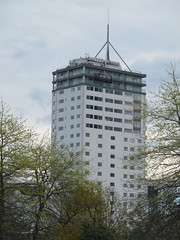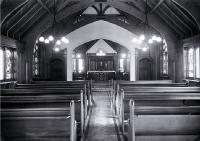Find out about Christchurch's streets and buildings.
Which is the tallest building in Christchurch?

The Pacific Tower, home to Rendezvous Hotel building at 166 Gloucester Street has 22 storeys and stands 73 metres high. It has a 13 metre spire which reaches to 86 metres. Christchurch’s top 20 tallest buildings are listed on the Emporis website.
The tallest buildings in Christchurch prior to their demolition were the Grand Chancellor Hotel at 85 metres, followed by the Price Waterhouse Cooper building 76.3 metres which was built in 1988.
Sources
- Christchurch hotel claims tallest status, TVNZ, 18 March 2010
- Pacific Tower to reopen by February The Press, 19 July 2012
- View our photos of the Pacific Tower on Flickr
Which is the oldest building in Christchurch?
The oldest building in Christchurch (and on the Canterbury plains) is Deans Cottage, built in 1843, and located in Riccarton Bush.

Sources
- Information about Riccarton Bush on our website
- Information about Deans family on our website
- Deans cottage - information on the Riccarton house and bush website
Christchurch streets
Find out what are the busiest, highest, longest and newest streets of Christchurch. As at January 2022, there are 3,938 roads owned by Christchurch City Council. They stretch for 2,439 kilometres - longer than the distance from Cape Reinga to Bluff (2,058 kilometres).
Alphabet
The first street is Abberley Crescent and the last street is Zinnia Way.
Widest
The widest single carriageway road in Christchurch is Whitmore Street which is 25m wide. However Linwood Avenue is the widest dual carriageway at 45m. This includes the cycleway and the planted central median.
Narrowest
Wells Back Road off Charlton Road on Banks Peninsula is 2.5 metres wide.
Busiest
Christchurch’s busiest street for foot traffic is Cashel Mall. It sees an average 8000 – 9000 pedestrians per day. For vehicle traffic Moorhouse Avenue is the busiest, with an average of 55,000 vehicles a day.
Longest
Our longest road is Summit Road which runs from the top of Evans Pass through to Gebbies Pass - a distance of 28 kilometres.
Shortest
Alcester Street off Durham Street at the South City Mall entrance clocks in as our shortest legal road at just 35m long.
Highest
Summit Road Akaroa is our highest street – it reaches 685m above sea level at the Hilltop Tavern.
Newest
The latest addition to our streetscape is in Wigram. Agathis Crescent takes the title of Christchurch’s newest street.
Street with the longest name
Sir William Pickering Drive which has 19 letters. Sir William was educated at Canterbury University before moving to the United States where he gained a PhD in physics and became the Director of the Jet Propulsion Laboratory in Pasadena.
Street with the shortest name
PA Road in Pigeon Bay, Banks Peninsula.
- Information from Street Talk, Fast Facts, Newsline, 27 January 2022.
- Find out how streets got their names: Christchurch street and place names
Christchurch buildings of interest
- Canterbury Provincial Government Buildings
- Christchurch Arts Centre
- Edmonds Band Rotunda
- Lyttelton Time-ball Station
- Nurses’ Memorial Chapel
- Christchurch Art Gallery Te Puna O Waiwhetu
- Christchurch Town Hall
- Horncastle Arena
Canterbury Provincial Government Buildings
The Canterbury Provincial Government Buildings are the only surviving purpose-built provincial government buildings in New Zealand. They were designed by Benjamin Mountfort and built in three stages, the first two in wood (1859 and 1860), and the third in stone (1865). They housed the provincial government which governed Canterbury until 1876 when these governments were abolished and were replaced by a system of one central government and town boards, boroughs, road and harbour boards
The buildings were severely damaged in the Christchurch earthquakes of 2010 and 2011. A programme of careful deconstruction to secure the building along with weatherproofing and retrieval and storage of material has been undertaken. The buildings are currently closed to the public. More information about the Canterbury Provincial Government Buildings
Christchurch Arts Centre
The buildings on this site were originally Canterbury College, later Canterbury University College, and later again the University of Canterbury. It was also the original site for Christchurch Girls’ High School and Christchurch Boys’ High School. The clock tower block (1877-79), Great Hall (1882) and Classics block (1888) were designed by Benjamin Mountfort. Other architects were also involved on the project including Samuel Hurst Seager, as ‘consultant architect’.
The Worcester Street site was decided on in 1876, and building began the following year. Most of the complex was built by the time of the 50th Jubilee of the College in 1923. By the 1950s the city site was becoming overcrowded. From 1957 departments of the University gradually moved to a new site at Ilam. By 1975 the University of Canterbury had completed the move to Ilam.
A trust was formed in 1978 to transform the former university buildings into the arts and cultural centre of Christchurch. The buildings include the Court Theatre, the Southern Ballet, cinemas, restaurants and art galleries.
The Arts Centre buildings were badly damaged in the Christchurch earthquakes and some of them remain closed. The first buildings to reopen after the earthquake were Registry, Registry Additions and The Gym with Registry reopening in July 2013. The Great Hall opened in June 2016. More information about the Arts Centre
Edmonds’ Band Rotunda
The rotunda was donated by Thomas Edmonds (of Edmonds’ “Sure to Rise” baking powder fame) to celebrate 50 years of living in Christchurch. It was designed by Victor Hean and was built in 1929. The rotunda was built for the performance of public band concerts. In 1987 it was converted to a restaurant.
![Edmonds Band Rotunda, viewed from Oxford Terrace [ca. 1930]](https://christchurchcitylibraries.com/Heritage/Photos/Disc10/IMG0072.jpg)
- Stage set for return of Christchurch's Thomas Edmonds Band Rotunda (Newsline, CCC)
- Edmonds band rotunda is finally open following an 'incredible' rebuild (Stuff)
Lyttelton Time-ball Station
The Lyttelton building was the only surviving time-ball station in New Zealand. The time-ball station operated by dropping a ball every day at 1 pm (Greenwich time). This signalled the opportunity for navigators on board ships in the port to note differences between the time-ball signal and their on-board chronometers (a special time-keeper designed for on board ships).
After some years delay, the time-ball station was built in 1876 to give visual time signals to ships in the port. The first official time signal given on 23 December 1876. The time-ball apparatus was made by German firm Siemens Brothers, and the clock mechanism was made by Edward Dent and Co. of London, the makers of Big Ben. It was housed in a three-storey building designed by the provincial architect, Thomas Cane in 1875, and built by the stonemason William Brassington, out of the local volcanic stone. The time-ball had to be raised by hand, but was released at the right time by an electrical system. With the development of radio the time-ball signal was no longer needed, and the last official drop to signal the time was given on 31 December 1934.
The station building fell into disrepair but was restored in the early 1970s and the time-ball was also restored to full working order. The original ball was still in place. It was one of only 5 in the world known to still be in working order.
The Time-ball station was badly damaged in the earthquakes of September 2010 and February and June 2011 and was later deconstructed. Rebuilding of the tower started in July 2017 with the time-ball itself being put back in place in June the following year. The Lyttelton time-ball tower was reopened to the public on 2 November 2018.
For more information see:
- Bremner, Julie. The Lyttelton time-ball station: an account of its history, operation and restoration
- Heritage New Zealand: Lyttelton Timeball Station
Nurses’ Memorial Chapel

Christchurch Art Gallery Te Puna O Waiwhetu
The Robert McDougall Gallery opened in June 1932, and was named after Robert Ewing Macdougall, a local businessman who donated the money for Christchurch’s first public art gallery. From the 1970s on the curators of the art gallery found it hard to stage major exhibitions because of the limited space in the Robert MacDougall building. The building was closed on 16 June 2002, and all its art works were gradually transferred to the new gallery.
The piece of land bordered by Montreal Street, Gloucester Street and Worcester Boulevard, was purchased by Christchurch City Council in 1996 as the site for the new gallery. It was designed by the Buchan Group, of Australia, and features a tinted glass wall 75 metres long and 14 metres high. The gallery has two floors of exhibition space, with nine exhibition areas. The building began in December 2000, and was carried out by C. Lund and Son Ltd. The total cost of $47.5 million was funded by the Community Trust of New Zealand, government grants and extensive fundraising and sponsorship, as well as the ratepayers of Christchurch through the Christchurch City Council. The new Christchurch Art Gallery was opened by the Prime Minister, Helen Clark, on 10 May 2003.
The building suffered damage as a result of the 2011 earthquakes. It reopened in December 2015. Read more information about the Christchurch Art Gallery building.
Christchurch Town Hall
Since its earliest years there have been many attempts to develop plans for a town hall for Christchurch, but none have been successful. The Christchurch Town Hall project was driven by Sir James Hay, who died before its completion, but who has had the theatre named after him. The site of the town hall, that of the old Limes Hospital on Kilmore Street, was bought in 1963 by the Christchurch City Council. Plans for the new building were designed by the Christchurch architectural firm, Warren and Mahoney, in 1966. The foundation stone was laid in 1969, and the town hall was officially opened in September 1972.
The Christchurch Town Hall complex features the Auditorium, designed as a concert hall and able to seat 2600, and the James Hay Theatre, used for theatrical productions and smaller recitals, and able to seat 1000. The Ferrier fountain, located on the river side of the town hall, was donated by a local businessman. The complex also houses a restaurant and smaller conference rooms. It has been supplemented as a conference venue by the construction of the Christchurch Convention Centre in 1997. The Christchurch Town Hall is home to the Christchurch Symphony, the Canterbury Opera, the Christchurch Operatic Society and the Christchurch City Choir.
The building was damaged in the Christchurch earthquakes of 2010 and 2011 and repairs were completed in 2019. More information about the Christchurch Town Hall.
Wolfbrook Arena
Wolfbrook Arena is New Zealand’s second largest indoor events arena, and was designed to host major sporting events exhibitions and concerts. It was designed by Barclay, Hodgskin Architects and built by Charles Luney. Construction began in December 1996, and was completed in September 1998 at a cost of $32 million. The Centre was officially opened by the mayor, Vicki Buck, in September 1998. It can seat up to 8,500 for concerts and 7,200 for centre court sporting events. The complex is home to the Canterbury Tactix netball team. It was originally called the WestpacTrust Centre and later Horncastle, then Christchurch Arena.
Sources
- Rice, Geoffrey. Christchurch changing: an illustrated history
- Turner, Gwenda. Gwenda Turner’s Christchurch: an enchanted journey through the Garden City
- Wilson, John. Historic Christchurch: a walking tour
More information about buildings
For information about other Christchurch buildings see Christchurch City Libraries' pages about Christchurch Places or Early Christchurch:
For photographs of some of Christchurch’s early buildings see:
If you want to find information about other famous buildings in the world try searching our catalogue using these subject headings:
If you want to know about a particular building, like the White House, try kids' eResources such as World Book Online for Kids.

